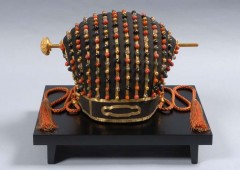2013.03.18
Michi-no Eki Kina Banjo takes it slow, like on days of yore
By Mana Komatsu
 Is this a museum? Or perhaps a resource center? Those are the questions that pop into mind when visiting the fourth Michi-no Eki in our series, Kina Banjo, where the atmosphere of the old Ryukyu Kingdom is deeply reflected.
Is this a museum? Or perhaps a resource center? Those are the questions that pop into mind when visiting the fourth Michi-no Eki in our series, Kina Banjo, where the atmosphere of the old Ryukyu Kingdom is deeply reflected.
Kina Banjo is located in Kina, Yomitan Village. It’s an hour drive north on route 58 from Naha, or

Groups of students often visit to learn about Okinawan history, which facility manager Aira Ishimine is happy to share.
ten minutes from KAB. This Michi-no Eki has characteristics very different from others as it has no restaurant or souvenir shop. There is only a historical architecture and a sense of time running slow.
Michi-no Eki Kina Banjo is a restoration of banjo which was built in the 1600s. Banjo were places that served as government offices in key locations where people were trading goods, engaging in cultural activities, and communicating with each other. In the old days Kina was located along a main road connecting Yanbaru in the north and Shuri Castle, and thus the banjo was built here. The original Banjo was destroyed during the Battle of Okinawa, and it had been preserved as a historically important site. It was rebuilt in 2005 to become Michi-no Eki Kina Banjo at the front door to Yomitan.
The restored building is very simple, but is meticulously reproduced in its original style, and several traditional construction methods were used.
The tiles on the roof are different from traditional Okinawan, and are gray in color. That was the original color for the Banjo, and the Yomitan Village wanted to recreate them exactly the way they had been. Souten Okuhara, who renovated tiles on Shuri castle, helped reproducing the color.
The interior was also designed in meticulous detail. Chaagi, a kind of rare wood, was used for its posts, Yomitan traditional pottery Yuntanza Yaki is used for the bathroom fixtures, and red soil from Yomitan for its floor.
“Several couples have visited here to take commemorative pictures using this historical place as a background. We also have had foreign visitors,” explains Aira Ishimine, a guide and a specialist for all things Yomitan in the facility.
Nowadays, students from elementary through university level often visit Kina Banjo, which is designated as a cultural property, when they learn Okinawan history and culture. The guide here introduces stories from the ancient past injecting funny jokes to lighten the atmosphere. “We learned a lot of old Okinawan history, and the traditional pottery that is in the restroom is nice,” a

Yuntanza Yaki, the traditional Yomitan pottery, is used for bathroom fixtures to emphasize the traditional sense of the building.
group of students from Fukuoka said.
A there are no shops, the facility mainly offers space to relax in the facility’s tatami rooms. And a point in case, in order to emphasize the slow pace of time in Kina Banjo there are no clocks.
Although Kina Banjo foes not sell any souvenirs it offers visitors a place to experience a few relaxing moments, and feel the good old days of Okinawa. When you visit Kina Banjo, the staff promises to greet you with a smile.
“I have become friends with a foreign woman who was traveling by herself, and then she started coming back here after her sightseeing tours around Okinawa. I was pleased.” says Ishimine. She always appreciates her work that gives her chances to see many people daily. Kina Banjo has a staff of three, and many visitors have become regulars just for a chance to meet and chat with them. Kina Banjo is open daily from 9 a.m. to 6 p.m. It is closed on the last day of the of the year and New Year’s Day. Brochures on local and Yomitan Village tourist attractions are available in Japanese, English, Chinese and Spanish.


 2024.07.07
2024.07.07 2024.07.02
2024.07.02 2024.06.11
2024.06.11 2024.06.03
2024.06.03 2024.05.02
2024.05.02 2024.04.26
2024.04.26 2024.04.04
2024.04.04 2024.04.02
2024.04.02 2024.03.03
2024.03.03 2024.02.26
2024.02.26






